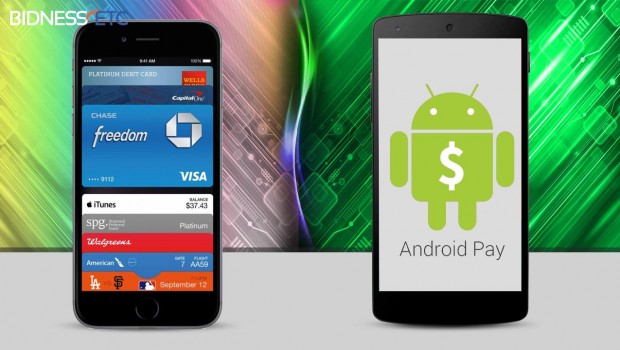Seamless mobile payments on Android
Debit Cards, credit cards, cash, coins or notes- forget searching through your wallet whenever you are shopping in a store. Imagine, how convenient it would be if you could pay with just a tap on your phone?
To add to the number of efficient mobile payment services, Google has introduced its latest, simple and secure mobile wallet – Android Pay.
Android pay is much into the talks on the tech streets owing to the convenience it promises to provide by enabling its users to pay with their Android phones. Android Pay is targeted at bringing the mobile carriers, payment networks, retailers and banks together to deliver choice and flexibility to the consumers. It will also offer an open platform to the developers, which can help in collectively pushing the mobile payment ecosystem forward. While, the yet-to-come mobile wallet has already created a lot of buzz on the tech streets, we have approached here to discuss every aspect of Android Pay- the latest member of the Android and mobile payment ecosystem.
Tap to pay at retail outlets
With Android Pay, the users will be able to pay in the stores with just a tap on their phones. All they’ll need to do is simply unlock their mobile device like they usually do, place it close to the merchant’s contactless terminal and they’re good to go. Capable of all the heavy lifting required to completing payments successfully, Android Pay would not even require users opening an app- just tap your device and go. A payment confirmation along with the transaction details will also be received right on the device.
Android Pay will not only let the contactless terminals receive the payment info but also they will communicate the details regarding loyalty programs and offers. With select retailers, the loyalty points and rewards will be automatically applied at checkout.
But, would it be sufficient enough for the consumers to adapt the newly arrived service leaving behind the rest. After all, out there standing is a whole big crowd of mobile payment services of which Apple Pay is the most talked about one.
Let’s see further if Android Pay possesses something more to lure the users.
Tap to pay in apps
The days of entering your card details and address each time you make an online purchase will soon be an incident of the past. The different innovations in the mobile payment space have vowed to kick-out the cash payment system. Android Pay will enable the consumer to pay by just selecting “Buy with Android Pay” within the app. This will leave them with the convenience of checking out as fast as a tap.
Google is partnering with top payment processors to make the integration even easier. In order to let the developers add Android Pay to their favorite apps, the mobile wallet has been designed to work seamlessly with any available payment processor.
The Android ecosystem has always faced a tough competition from Apple. This time as well, the tech giant has already put forward its new payment system- Apple Pay, which in no way behind Android pay when it comes to the ability to pay with a tap.And of course, most of the mobile wallets will offer this feature.
Your choice of payment
Android Pay will let the users pay with their debit or credit cards, across multiple smart devices and at thousands of retail outlets and apps that they have been already visiting. By enabling the bank apps to integrate with Android Pay, the users can connect their card details directly from the bank apps for usage with Android Pay.
Here, turning things in favor of Android Pay is the fact that there is a comparatively larger crowd using Android devices than the ones using iOS devices. While Android Pay will be available to all those using smartphones running on Android 4.4 or above, the Apple Pay has been limited to iPhone 6 and 6 plus along with the Apple watch only.
The security-centric Android Pay
The security of personal and financial data is really important for the users and thus, Android Pay is integrating with leading payment networks in order to extend industry standard tokenization and data encryption to support the mobile money security.
So, when a user will shop at some retail outlet, Android Pay would not send his actual card number with the payment. Instead, it will use a virtual account number for representing the account details- providing its users with an extra security layer.
While Android Pay as well as Apple Pay leverage the tokenization system and thus we can say that with the biggest of security partners like Visa, MasterCard etc. Android Pay can be the next big thing following Apple Pay.
Until now, we have found that Android pay has left no stones unturned to compete in the combat with Apple Pay. Let’s take a glance at the points of difference between them:
- Since Apple owns the hardware, it has leveraged the embedded secure element. The iPhone’s hardware component will also store the tokens and other sensitive data. Whereas, Google is relying on Host Card Emulation for the same.
- Android Pay enabled devices will be able to complete only a limited number of transactions in the disconnected mode. Apple Pay does not apply any such restriction.
- While Apple Pay relies on biometrics for user authentication; Google is still relying on PIN and unlock patterns for the same. We may anticipate an up-gradation with the arrival of Android M.
How does it impact other mobile wallets?
In order to access the impact that Android Pay will place on the other mobile wallets a little more clarity is required on what it entails.
We may anticipate the Android Pay leveraging tokenization and HCE would be a Google mandatory service in the upcoming Android M and thus, it would not be exposed to third party applications. This implies that any mobile device running on Android M platform would have to mandatorily complete transactions using Android Pay only. The other applications would not gain access to the NFC controller on the device, making it unlikely for any other mobile wallet to offer NFC payments. However, this scenario seems to be limited to the USA only.
Markets other than the USA don’t have distinct issuance and acquiring entities. Most banks sell as much cards as much they acquire merchants. This along with some other factors listed below will impact the adoption and business model:
- The regulatory hurdles make the model unviable
- Both Android Pay and Apple Pay arrive pre-integrated with tokenization platforms making the availability of MDES and VTS mandatory in the country.
- Presence of contactless acceptance is poor to non-existence in many countries.
There may likely be a case that the banks may not be able to launch their own payment wallets even if they have their own tokenization solution in case Android Pay for HCE is a GMS not exposed to any third party application.
The Google window has little space as opportunity but along with a number of conditions. Android Pay seems to be banking of software security for securing the tokens. Use of hybrid solutions for authentic payments and location detection can further fortify the solution.
Stay Tuned
Apple has declared that it would not capture the user payment data while we may anticipate Google to leverage this data in order to better target the value added services. Thus, Google can be expectedto launch loyalty programs and rewards quite earlier than Apple.
The clock is ticking for Google to launch the Android Pay. It will be available for download at the Google Play Store very soon. It would be quite interesting to see how it competes with Apple Pay- its cutting edge competitor on the verge of acquiring users.
Whoever wins, we would be looking forward to a day when everyone can walk out their doors cashless, ready to use a mobile payment enabled smart device!
About this article:
The article is authored by Mahindra Comviva Team. Mahindra Comviva is the global leader in providing mobility solutions. It is a subsidiary of Tech Mahindra and a part of the USD 16.5 billion Mahindra Group. With an extensive portfolio spanning mobile finance, content, infotainment, messaging and mobile data solutions, Mahindra Comviva enables service providers to enhance customer experience, rationalize costs and accelerate revenue growth.
















